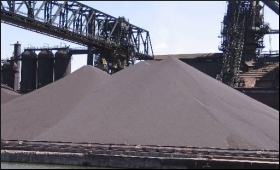|
|
|

|
CII seeks withdrawal of export duty on low grade iron ore
|
|

|
|
| Top Stories |
 |
|
|
|
IANS | 23 Aug, 2022
CII has said that the circular by the Ministry of Finance regarding
imposition of 45 per cent export duty on low grade iron ore and
enhancement of export duty on iron ore from 30 per cent to 50 per cent
(all grades) will have cascading and adverse impact over Indian Iron Ore
mining industry.
CII said the earlier regime (NIL duty
on below 58Fe and 30 per cent duty on above 58Fe) was apt for India. The
30 per cent duty on above 58Fe ensured domestic need was given
priority, including that of MSMEs (sponge iron plants, pellet plants,
etc.) as well as large players (integrated steel plants). Nil duty on
below 58Fe ensured that whatever was not needed domestically could be
monetized to reduce the overall cost of iron ore production in country.
There
is no shortage of iron ore to meet domestic demand -- either today or
in future, even to meet the National Steel Policy target of 300 MT steel
capacity by 2030, CII said.
Export was the only option for low
grade ore (below 58 per cent Fe), which is now unviable due to 50 per
cent duty and will rather add to mineral inflation and adverse impacts.
During
the mining of high-grade ore to meet domestic consumption, low grade
ore (not in domestic use) has to be mined and liquidated to keep overall
production cost in control -- a natural measure to control mineral
inflation. If low grade iron ore is not exported, then total mineral
production in the country will reduce, owing to space constraint to
store below 58Fe grade within mines (high inventory cost for this grade
with no market access).
As a result, royalty and revenues to the
states will reduce, since below 58Fe grade will remain unsold, CII
pointed out. It will be a major hit on the mining sector, with
corresponding drop-in economic activity especially in remote mining
regions, loss of livelihoods, etc. Huge stockpiles of low-grade iron ore
fines, which comprise almost 75 per cent of mined ore, will either
cause dust pollution due to winds in summer or water pollution due to
rains in monsoon, CII said.
|
|
|
| |
|
|
|
|
|
|
|
|
|
|
|
|
|
|
| |
| Customs Exchange Rates |
| Currency |
Import |
Export |
US Dollar
|
84.35
|
82.60 |
UK Pound
|
106.35
|
102.90 |
Euro
|
92.50
|
89.35 |
| Japanese
Yen |
55.05 |
53.40 |
| As on 12 Oct, 2024 |
|
|
| Daily Poll |
 |
 |
| Do you think Indian businesses will be negatively affected by Trump's America First Policy? |
|
|
|
|
|
| Commented Stories |
 |
|
|
|
|
|
| |
|